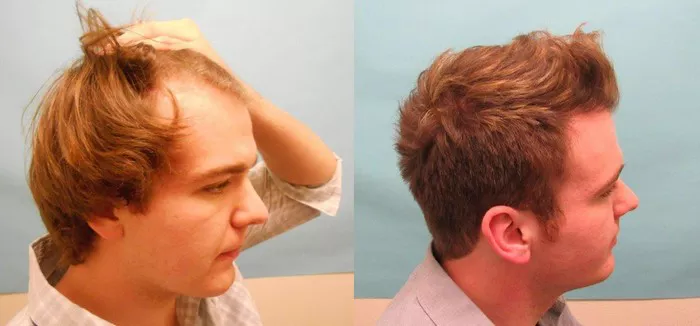Hair loss, including receding hairlines, can be a distressing experience for many individuals. Whether due to genetics, hormonal changes, medical conditions, or lifestyle factors, the prospect of a receding hairline can raise questions about whether the hairline will grow back. In this article, we’ll explore the possibility of hairline regrowth, highlighting factors that influence hair growth and providing insights into strategies for promoting regrowth.
Understanding Hair Growth:
Hair growth cycle: Hair grows in a cyclical process that consists of three phases: anagen (growth phase), catagen (transitional phase), and telogen (resting phase). During the anagen phase, hair actively grows, while the catagen and telogen phases involve hair shedding and resting.
Hair follicle health: The health of hair follicles plays a crucial role in hair growth. Healthy hair follicles produce strong, vibrant hair, while damaged or inactive follicles may result in hair thinning or loss.
Blood flow and nutrients: Adequate blood flow and nutrient supply to the scalp are essential for promoting hair growth. Blood carries oxygen and nutrients to the hair follicles, supporting their growth and vitality.
Factors Influencing Hairline Regrowth:
Genetics: Genetic factors play a significant role in determining hairline regrowth potential. Individuals with a family history of pattern baldness or thinning hair may have a predisposition to hair loss, making it more challenging to achieve hairline regrowth.
Hormonal changes: Hormonal fluctuations, such as those associated with puberty, pregnancy, childbirth, and menopause, can impact hair growth and affect hairline regrowth. Balancing hormone levels through medical treatment or lifestyle changes may support regrowth.
Medical conditions: Underlying medical conditions, such as thyroid disorders, autoimmune diseases, scalp infections, or alopecia areata, can interfere with hair growth and inhibit hairline regrowth. Treating the underlying condition is essential for promoting regrowth.
Age: Age-related changes in hormone levels, hair follicle function, and scalp health can affect the ability of the hairline to grow back. While hairline regrowth may be more challenging with age, it is still possible with proper treatment and care.
Lifestyle factors: Lifestyle choices, such as diet, stress levels, smoking, and hair care practices, can impact hair health and affect hairline regrowth. Adopting healthy habits and avoiding damaging practices can support regrowth efforts.
Strategies for Promoting Hairline Regrowth:
Topical treatments: Over-the-counter and prescription topical treatments, such as minoxidil (Rogaine) or topical corticosteroids, can help stimulate hair follicles and promote hairline regrowth. These treatments are applied directly to the scalp and can be effective for some individuals.
Oral medications: Prescription medications, such as finasteride (Propecia) or spironolactone, may be prescribed to address underlying hormonal imbalances and support hairline regrowth. These medications work by blocking the hormone responsible for hair loss or regulating hormone levels.
Hair transplant surgery: Hair transplant surgery involves transplanting hair follicles from donor areas to the thinning or balding areas of the scalp. This procedure can restore a natural-looking hairline and promote regrowth in areas of hair loss.
Low-level laser therapy: Low-level laser therapy (LLLT) devices, such as laser combs or helmets, can help stimulate hair follicles and improve scalp health, promoting hairline regrowth. These devices emit low-level laser light that penetrates the scalp and stimulates cellular activity.
Scalp micropigmentation: Scalp micropigmentation (SMP) is a non-surgical cosmetic procedure that involves tattooing tiny dots or lines onto the scalp to mimic the appearance of hair follicles. This technique can create the illusion of a fuller head of hair and camouflage areas of hair loss.
Conclusion:
While the prospect of hairline regrowth may seem daunting, it is indeed possible with the right approach and treatment strategies. By understanding the factors influencing hair growth, addressing underlying issues, and implementing effective regrowth techniques, individuals can achieve a fuller, healthier hairline. Whether through topical treatments, oral medications, hair transplant surgery, low-level laser therapy, or scalp micropigmentation, there are various options available for promoting hairline regrowth. Remember to consult with a healthcare professional or dermatologist to determine the best course of action based on your individual needs and goals. With patience, persistence, and proper care, you can restore your hairline and regain your confidence.
In conclusion, while hairline regrowth may vary depending on individual factors and circumstances, it is possible with the right approach and treatment strategies. By addressing underlying causes, promoting scalp health, and exploring effective regrowth techniques, individuals can achieve a fuller, healthier hairline. Remember to be patient and consistent in your efforts, and consult with a healthcare professional for personalized guidance and recommendations. With dedication and perseverance, you can restore your hairline and enjoy the confidence that comes with a full head of hair.
How To Make Your Hair Curly Again After Straightening

